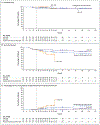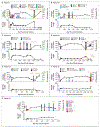Hematologic Cancer after Gene Therapy for Cerebral Adrenoleukodystrophy
- PMID: 39383458
- PMCID: PMC11846662
- DOI: 10.1056/NEJMoa2405541
Hematologic Cancer after Gene Therapy for Cerebral Adrenoleukodystrophy
Abstract
Background: Gene therapy with elivaldogene autotemcel (eli-cel) consisting of autologous CD34+ cells transduced with lentiviral vector containing ABCD1 complementary DNA (Lenti-D) has shown efficacy in clinical studies for the treatment of cerebral adrenoleukodystrophy. However, the risk of oncogenesis with eli-cel is unclear.
Methods: We performed integration-site analysis, genetic studies, flow cytometry, and morphologic studies in peripheral-blood and bone marrow samples from patients who received eli-cel therapy in two completed phase 2-3 studies (ALD-102 and ALD-104) and an ongoing follow-up study (LTF-304) involving the patients in both ALD-102 and ALD-104.
Results: Hematologic cancer developed in 7 of 67 patients after the receipt of eli-cel (1 of 32 patients in the ALD-102 study and 6 of 35 patients in the ALD-104 study): myelodysplastic syndrome (MDS) with unilineage dysplasia in 2 patients at 14 and 26 months; MDS with excess blasts in 3 patients at 28, 42, and 92 months; MDS in 1 patient at 36 months; and acute myeloid leukemia (AML) in 1 patient at 57 months. In the 6 patients with available data, predominant clones contained lentiviral vector insertions at multiple loci, including at either MECOM-EVI1 (MDS and EVI1 complex protein EVI1 [ecotropic virus integration site 1], in 5 patients) or PRDM16 (positive regulatory domain zinc finger protein 16, in 1 patient). Several patients had cytopenias, and most had vector insertions in multiple genes within the same clone; 6 of the 7 patients also had somatic mutations (KRAS, NRAS, WT1, CDKN2A or CDKN2B, or RUNX1), and 1 of the 7 patients had monosomy 7. Of the 5 patients with MDS with excess blasts or MDS with unilineage dysplasia who underwent allogeneic hematopoietic stem-cell transplantation (HSCT), 4 patients remain free of MDS without recurrence of symptoms of cerebral adrenoleukodystrophy, and 1 patient died from presumed graft-versus-host disease 20 months after HSCT (49 months after receiving eli-cel). The patient with AML is alive and had full donor chimerism after HSCT; the patient with the most recent case of MDS is alive and awaiting HSCT.
Conclusions: Hematologic cancer developed in a subgroup of patients who were treated with eli-cel; the cases are associated with clonal vector insertions within oncogenes and clonal evolution with acquisition of somatic genetic defects. (Funded by Bluebird Bio; ALD-102, ALD-104, and LTF-304 ClinicalTrials.gov numbers, NCT01896102, NCT03852498, and NCT02698579, respectively.).
Copyright © 2024 Massachusetts Medical Society.
Figures


Comment in
-
Myelodysplasia after Lentiviral Gene Therapy.N Engl J Med. 2024 Dec 19;391(24):2382. doi: 10.1056/NEJMc2414069. N Engl J Med. 2024. PMID: 39693551 No abstract available.
-
Myelodysplasia after Lentiviral Gene Therapy.N Engl J Med. 2024 Dec 19;391(24):2382-2383. doi: 10.1056/NEJMc2414069. N Engl J Med. 2024. PMID: 39693552 No abstract available.
-
Myelodysplasia after Lentiviral Gene Therapy.N Engl J Med. 2024 Dec 19;391(24):2383-2384. doi: 10.1056/NEJMc2414069. N Engl J Med. 2024. PMID: 39693553 No abstract available.
-
Myelodysplasia after Lentiviral Gene Therapy. Reply.N Engl J Med. 2024 Dec 19;391(24):2384. doi: 10.1056/NEJMc2414069. N Engl J Med. 2024. PMID: 39693554 No abstract available.
References
-
- Moser HW, Mahmood A, Raymond GV. X-linked adrenoleukodystrophy. Nat Clin Pract Neurol 2007;3:140–51. - PubMed
-
- Raymond GV, Moser AB, Fatemi A. X-linked adrenoleukodystrophy. In: Adam MP, Feldman J, Mirzaa GM, et al. , eds. GeneReviews. Seattle: University of Washington, 1993. (http://www.ncbi.nlm.nih.gov/books/NBK1315/). - PubMed
-
- Mahmood A, Raymond GV, Dubey P, Peters C, Moser HW. Survival analysis of haematopoietic cell transplantation for childhood cerebral X-linked adrenoleukodystrophy: a comparison study. Lancet Neurol 2007;6:687–92. - PubMed
Publication types
MeSH terms
Substances
Associated data
Grants and funding
LinkOut - more resources
Full Text Sources
Medical
Research Materials
Miscellaneous
